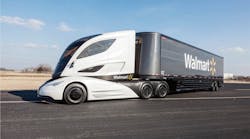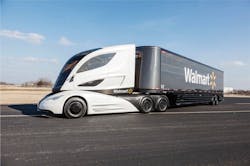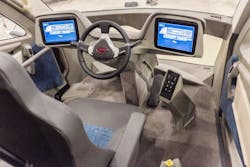As part of its plan to double the efficiency of its 6,000-truck fleet, Walmart Corp., Bentonville, Ark., worked with several companies to build the Walmart Advanced Vehicle Experience (Wave). It is a testbed of cutting-edge technologies that might show up in the next generation of trucks and trailers used to deliver goods across the country.
The futuristic Wave truck includes several improvements, courtesy of partners Capstone Turbine, Great Dane Trailers, Peterbilt, and Roush Engineering. On the outside, the truck sports LEDs for most lighting needs. This cuts weight and power requirements. And the truck is put together using advanced high-strength adhesives rather than rivets. This simplifies assembly and cuts inventory costs. Other features include:
Aerodynamics: Engineers redesigned the cab and trailer using CFD to cut aerodynamic drag by 20% compared to the newest conventional trucks on the road. The wheelbases have also been shortened by mounting the cab over the engine. This reduces the truck’s weight and improves its maneuverability.
Hybrid powerplant: The truck’s engine, a range-extending series-hybrid, uses much smaller and lighter batteries than pure electric trucks. The engines are well suited to the shorter trips and lower speeds that characterize most Walmart deliveries (Walmart distribution centers are now closer to metropolitan areas so final-delivery trucks make shorter trips.) These shorter trips also create more opportunities to recover energy through regenerative braking. The generators and energy-storage devices on the truck are scalable to the needed range.
Microturbine power: A small turbine on the hybrid engine improves fuel economy and gives the truck a greater range. The hybrid powertrain lets the turbine spin at its most-efficient speed, while the electric motor/energy-storage device handles acceleration and deceleration. Trucks scheduled for longer trips would be outfitted with larger turbines and smaller energy-storage devices.
Fuel neutrality: Turbines can use a wide variety of fuels, including diesel, natural gas, and biodiesel, while generating few emissions without the need for aftertreatment. Turbines also have few moving parts which reduces maintenance requirements and weight.
Charge mode: In this mode, sensors determine the batteries’ state of charge and start charging using the turbine if needed. Drivers can select charge mode if they want to “top off” the batteries prior to shutting down.
Electric-vehicle mode: The truck runs on electric power alone, usually on urban streets, until the battery charge drops to 50%. At that point, the turbine starts and begins charging the batteries.
Hybrid-electric mode: For maximum range, the turbine runs continuously, only shutting down if the batteries run out.
Component electrification: The truck uses scaled-up versions of automotive subsystems powered by electric motors instead of hydraulics. They include power steering and air conditioning.
Trailer: The vehicle’s trailer is built almost exclusively from carbon fiber, including one-piece panels for the roof and sidewalls, saving nearly 4,000 lb compared to traditional designs. The trailer’s convex nose also improves aerodynamics while providing storage space inside the trailer. Other features include low-amperage LED lighting strips, composite trailer skirts, aerodynamic wheel coverings, a posi-lift suspension, and a one-piece, fiberglass-reinforced floor panel with a 16,000-lb forklift rating.
Cab: the driver’s compartment has a lightweight sliding door and a simplified dashboard with fewer controls and displays. Instead, customizable LCDs let drivers keep clutter to a minimum. There’s a also a full-sized sleeper with a fold-down bed. n


